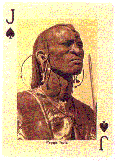
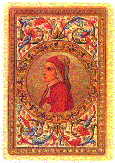
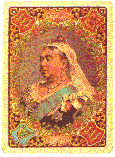
![Cotta Transformation Cards]](graphics/art1pic1.gif)
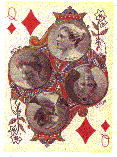
 When I was asked to write this article, I wondered, what will I write about? About the endless hours looking for playing cards in all the antique shops, shows, flea markets, and garage sales that I never thought would be possible? But that is NOT what I will write.
When I was asked to write this article, I wondered, what will I write about? About the endless hours looking for playing cards in all the antique shops, shows, flea markets, and garage sales that I never thought would be possible? But that is NOT what I will write. (Pictured at right: The Stage - Made in the U.S.A. in 1896, each card shows four photos of famous people on the American stage.)
(Pictured at right: The Stage - Made in the U.S.A. in 1896, each card shows four photos of famous people on the American stage.) I will first tell you about some of the history of the pack. There is speculation that the earliest packs were made in Italy, Germany or Persia. The earliest, hand coloured, because of the amount of work in producing them, were mostly used by the wealthy and royalty. In the 15th century, when wood block printing came into being, playing cards were massed produced and became available to the common man. Because cards were being made in so many countries by the 16th century, there were various suit-systems being used. The common one used in Britain and America is the French suits with anglicized names.
I will first tell you about some of the history of the pack. There is speculation that the earliest packs were made in Italy, Germany or Persia. The earliest, hand coloured, because of the amount of work in producing them, were mostly used by the wealthy and royalty. In the 15th century, when wood block printing came into being, playing cards were massed produced and became available to the common man. Because cards were being made in so many countries by the 16th century, there were various suit-systems being used. The common one used in Britain and America is the French suits with anglicized names. There are different suits signs (the ones in the corners) used in Greece, Holland, Germany, the U.S.S.R., the Scandinavian countries, France and many more.
There are different suits signs (the ones in the corners) used in Greece, Holland, Germany, the U.S.S.R., the Scandinavian countries, France and many more. But, you must know all this eh? You must know that there are MANY playing card collectors in MANY clubs. Two of the more popular clubs are "The American Antiquarian Playing Card Society," commonly known as "52 + Joker," and the "English Playing Card Society." There are clubs in Belgium, Australia, France and many more. There are major collections that have been donated to the British Museum, and to Yale University.
But, you must know all this eh? You must know that there are MANY playing card collectors in MANY clubs. Two of the more popular clubs are "The American Antiquarian Playing Card Society," commonly known as "52 + Joker," and the "English Playing Card Society." There are clubs in Belgium, Australia, France and many more. There are major collections that have been donated to the British Museum, and to Yale University. But, that is NOT what I will write about.
But, that is NOT what I will write about.
 |
 |
 |
| East African Souvenir: Made by Fournier of Spain in 1960, showing scenes and natives on all cards. | Dante & Beatrice: Made by Piatnik of Austria in 1923, showing royalty of the era. | Victorian Jubilee: Made by Goodall in England in 1897 to celebrate the 60th year of Victoria's reign. |
 I will tell you of the countless hours of joy that I have had in looking at, and admiring, the more than 2,000 packs in my own collection. I have cards from 70-odd countries, which come in every imaginable size and shape, square, round, triangular, concave, convex, S-shaped, and from 0.25" to 12" in length.
I will tell you of the countless hours of joy that I have had in looking at, and admiring, the more than 2,000 packs in my own collection. I have cards from 70-odd countries, which come in every imaginable size and shape, square, round, triangular, concave, convex, S-shaped, and from 0.25" to 12" in length. I have cards made of aluminum, cards of paper mache, and even cards, that when held to the light, show pornographic drawings.
I have cards made of aluminum, cards of paper mache, and even cards, that when held to the light, show pornographic drawings. In the 600 years since playing cards came into being, there have been enormous changes in the manufacture. From hand-painted, to wood blocks, to letter press, to lithography.
In the 600 years since playing cards came into being, there have been enormous changes in the manufacture. From hand-painted, to wood blocks, to letter press, to lithography. At one time cards were banned in Britain, as being the work of the Devil. Prisoners of war have been known to make cards of bone, and at one time cards were written on and used as a form of currency by the military. They have been written on as invitations, and death notices.
At one time cards were banned in Britain, as being the work of the Devil. Prisoners of war have been known to make cards of bone, and at one time cards were written on and used as a form of currency by the military. They have been written on as invitations, and death notices. Many cards in the early 1900's were made with photos on each card showing scenes of the locale. I have one made by Goodall of England of the City of Toronto. It was made in 1915 and the photo of the skyline is amazing, as it does not show the Royal York Hotel, which had not yet been built.
Many cards in the early 1900's were made with photos on each card showing scenes of the locale. I have one made by Goodall of England of the City of Toronto. It was made in 1915 and the photo of the skyline is amazing, as it does not show the Royal York Hotel, which had not yet been built. I have three packs showing photos of the Panama Canal. The first showing the trenches being built and photos of the old equipment being used. The second shows the middle stages, with photos of the workers and the huts they lived in. The third made on the completion of the canal, with different cards showing many of the ships in the U.S. Naval fleet.
I have three packs showing photos of the Panama Canal. The first showing the trenches being built and photos of the old equipment being used. The second shows the middle stages, with photos of the workers and the huts they lived in. The third made on the completion of the canal, with different cards showing many of the ships in the U.S. Naval fleet. Many artists, over the years, have designed packs. I have ones designed by Salvador Dali, one by Erte, and many packs with a different artist's work on each card. I recently was shown a pack hand painted by Claude Monet, and valued at $300,000. Would I have loved to find THAT at a garage sale.
Many artists, over the years, have designed packs. I have ones designed by Salvador Dali, one by Erte, and many packs with a different artist's work on each card. I recently was shown a pack hand painted by Claude Monet, and valued at $300,000. Would I have loved to find THAT at a garage sale.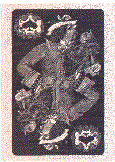 |
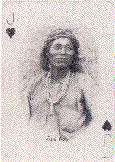 |
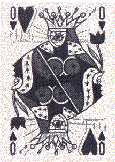 |
| Paleh Pack: Made in U.S.S.R. in 1967 to celebrate the 150th year of the playing card industry in the Soviet Union. | American Indian Souvenir: Made by U.S.P.C. in 1900, each card shows photos of various Indians tribes. | Salvador Dali: Cards designed by famous painter in 1967, made by Puiforcat of Paris. Each card specifically designed by Dali. |
 There are packs of Sterling silver, cards made of ivory, and the early American Indians even made their own cards out of leather.
There are packs of Sterling silver, cards made of ivory, and the early American Indians even made their own cards out of leather. Every major author in the last 100 years has written some story about the playing of card games. A 1929 edition of The Official Rules of Card Games (Hoyle up-to-date), published by the U.S. Playing Card Co., lists 165 different games or ways to play: AMAZING!
Every major author in the last 100 years has written some story about the playing of card games. A 1929 edition of The Official Rules of Card Games (Hoyle up-to-date), published by the U.S. Playing Card Co., lists 165 different games or ways to play: AMAZING! Cards have graced the covers of most major magazines such as "Life" and "Antique Showcase." Cards have been made for the last eight Presidents, and coronation packs for every monarch since Victoria.
Cards have graced the covers of most major magazines such as "Life" and "Antique Showcase." Cards have been made for the last eight Presidents, and coronation packs for every monarch since Victoria. There are many packs advertising cigarettes, and a pack made to condemn them. They have been made for Tiffany, and Cartier -- to advertise Railways, Ocean Liners, Airlines and Bus Lines. They were made for Baseball, Hockey, Football, the Olympics, Super Bowls and Golf.
There are many packs advertising cigarettes, and a pack made to condemn them. They have been made for Tiffany, and Cartier -- to advertise Railways, Ocean Liners, Airlines and Bus Lines. They were made for Baseball, Hockey, Football, the Olympics, Super Bowls and Golf.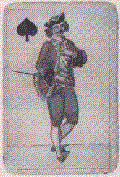
 (Pictured at right: Translucents - Made by Hersent & Bergeret in 1820, court cards are hand painted and when held to the light shows pornographic pictures. French.)
(Pictured at right: Translucents - Made by Hersent & Bergeret in 1820, court cards are hand painted and when held to the light shows pornographic pictures. French.) So why do I collect them? I just LOVE to look at them. To admire the beauty, the history, and the wonderment of the art.
So why do I collect them? I just LOVE to look at them. To admire the beauty, the history, and the wonderment of the art. I learnt to use a computer because of them. That way I keep a record of each pack.
I learnt to use a computer because of them. That way I keep a record of each pack. Because of my hobby, I've met wonderful people. Ones who collect for me, and many special dealers who look for cards for me.
Because of my hobby, I've met wonderful people. Ones who collect for me, and many special dealers who look for cards for me. So, when you next see me, with my sign, "I BUY OLD PLAYING CARDS," hanging from my chest, don't tell me. I just threw some away, or I didn't know people collect them, or: Do people really collect old playing cards?
So, when you next see me, with my sign, "I BUY OLD PLAYING CARDS," hanging from my chest, don't tell me. I just threw some away, or I didn't know people collect them, or: Do people really collect old playing cards? Remember, collecting ANYTHING is a joy to cherish and enjoy, and to educate.
Remember, collecting ANYTHING is a joy to cherish and enjoy, and to educate.